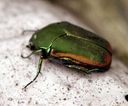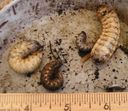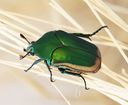Green Fig Beetle
Cotinis mutabilis
Classification
- Phylum: Arthropoda
- Subphylum: Hexapoda
- Class: Insecta
- Order: Coleoptera
- Suborder: Polyphaga
- Superfamily: Scarabaeoidea
- Family: Scarabaeidae
- Subfamily: Cetoniinae
- Tribe: Gymnetini
- Genus: Cotinis
- Species: mutabilis
Pronunciation
How to pronounce Cotinis mutabilis: /koʊˈtaɪnɪs mjuˈtæbɪlɪs/
These audio files are automatically generated. While they are not always 100% accurate, they are a good starting point.
Images






Summary
Cotinis mutabilis, commonly known as the figeater beetle or green fig beetle, is a widely variable scarab beetle native to the southwestern United States and Mexico, known for its colorful appearance and diet that includes ripe fruit.
Physical Characteristics
Adults grow to approximately 1.25 inches (3.2 cm) and are a semi-glossy green on the top with a brilliant iridescent green underside and legs. Hind legs are generally unicolorous.
Identification Tips
Confused with the green June beetle (Cotinis nitida) and Japanese beetles (Popillia japonica), but distinguished by color and habitat preference. C. nitida is smaller and primarily found in the eastern US.
Habitat
Primarily found in tropical and subtropical forests, oak forests, and cloud forests. Also inhabits urban areas and gardens.
Distribution
California to Texas, Mexico, and northern South America with a range extending throughout almost all of Mexico.
Diet
Adults feed on ripe or overripe fruit, preferring soft-skinned varieties such as figs, peaches, grapes, pears, and tomatoes. Larvae feed on decomposing organic matter in compost and manure piles.
Life Cycle
Eggs are laid in decaying organic matter; larvae develop in this medium and pupate in the spring. Adults emerge from July to September.
Reproduction
Oviposits in late summer in decaying organic matter such as compost or dung where the larvae develop.
Ecosystem Role
Plays a role in decomposing organic matter through its larvae feeding on it and helps in pollination as adults feed on flowers.
Economic Impact
Can become minor pests in gardens; while they can swarm and damage crops, especially soft fruits, they are not considered major pests currently.
Similar Taxa
Misconceptions
Often mistaken for similar beetle species, leading to confusion in identification.
Tags
- beetle
- scarab
- Cotinis
- Cetoniinae
- entomology